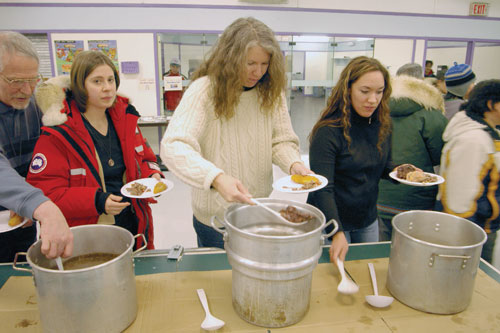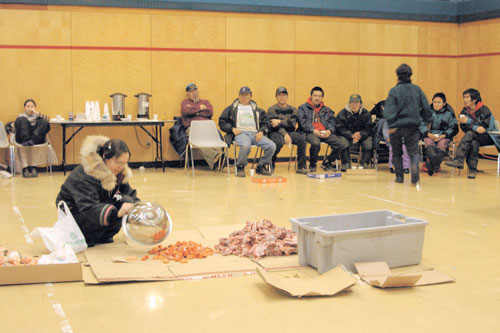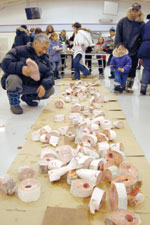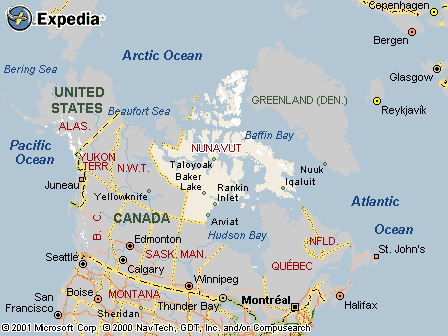|
|
Canku Ota |
|
|
(Many Paths) |
||
|
An Online Newsletter Celebrating Native America |
||
|
February 7, 2004 - Issue 106 |
||
|
|
||
|
Feasts Spread Word About Good Nutrition |
||
|
by JANE GEORGE - Nunatsiaq
News
|
||
|
"Country foods are still the best ... for you and your family"
The committee has been touring communities in the Baffin region to discuss contaminants in foods and talk about the benefits of a traditional diet. "We're trying to set people at ease ... we stress the importance that despite what you may have heard and concerns you may have, country foods are still the best source of food for you and people in your family," said Eric Loring, who represents the Inuit Tapiriit Kanatami on the tours. At each stop, members of the committee, which includes local and territorial health workers as well as representatives from government and Inuit organizations, meet with residents and host a country foods feast. The visits are the next step in the Northern Contaminants Program, which will put more focus on the link between contaminants and human health. The goal is to offer Inuit information so they can make informed choices. Community meetings generally start in the afternoon, with a visual presentation. "It's hands on. It's made so it's interactive and people understand what the concepts mean," Loring said. Community health representatives and regional nutritionists talk about what's good about country foods. Amy
Caughey, a diet promotion specialist with the GN, said people really
want to know how store-bought foods compare to country foods. The overall approach is positive, because, as Loring points out, it hasn't worked telling smokers not to smoke. "We're really emphasizing the positive and giving people choices. It's not like, 'don't eat seal blubber or narwhal.' It's like if you have the choice, cut some of the fat off,'" Loring said. "We're trying to push benefits and give people information so they can make choices.... So we're really trying to say, 'Hey, first of all, all country foods are good for you and the number one important thing is that you have to eat well.'" The committee still suggests pregnant women avoid alcohol and tobacco and eat a varied nutritious diet, choosing country foods, such as Arctic char, which are high in nutritional value but low in contaminants, over high-fat foods, such as maktak, which contain more potentially damaging contaminants. However, many pregnant women with poor nutritional habits aren't concerned about contaminants. A more healthy diet for these women is the committee's goal. "You could get a little bit of a contaminant load [rather] than not eating anything than pops or beef jerky," Loring said. As
they visit each community and receive feedback, committee members
also hope to guide researchers and decision-makers toward incorporating
more Inuit Qaujimajatuqangit or traditional knowledge into the study,
assessment and communication of contaminants.
On the Baffin portion of the tour, turnouts for the committee meetings have been good. The smallest audience was 14 in Resolute Bay, although more than 100 showed up in Pangnirtung and 45 in tiny Grise Fiord. From Feb. 10 to 17, the committee will visit Whale Cove, Arviat, Baker Lake, Rankin Inlet, Repulse Bay, Coral Harbour and Chesterfield Inlet. From March 3 to 9, it will visit Kugaaruk, Taloyak, Gjoa Haven, Cambridge Bay and Kugluktuk. A date for Sanikiluaq has yet to be set. At the end of March, representatives from the regional committees will meet in Ottawa to plan how to continue education and communication efforts on contaminants. |
|
|
www.expedia.com |
|
|
||
|
|
||
| Canku Ota is a free Newsletter celebrating Native America, its traditions and accomplishments . We do not provide subscriber or visitor names to anyone. Some articles presented in Canku Ota may contain copyright material. We have received appropriate permissions for republishing any articles. Material appearing here is distributed without profit or monetary gain to those who have expressed an interest. This is in accordance with Title 17 U.S.C. Section 107. | ||
|
Canku Ota is a copyright © 2000, 2001, 2002, 2003, 2004 of Vicki Lockard and Paul Barry. |
||
 |
 |
|
|
The "Canku Ota - A Newsletter Celebrating Native America" web site and its design is the |
||
|
Copyright © 1999, 2000, 2001, 2002, 2003, 2004 of Paul C. Barry. |
||
|
All Rights Reserved. |
||
 Country
food is good for you - that's the message from Nunavut's Niqiit
Avatittinni Committee.
Country
food is good for you - that's the message from Nunavut's Niqiit
Avatittinni Committee. "One
thing we do is a fat and sugar demonstration. We show examples of
how much sugar or fat is in certain goods," she said. "We
use Crisco to show how much fat is in foods. In a small bag of chips,
there's five teaspoons of fat. In a serving of caribou there's only
half a teaspoon, so people get a real sense ... it's very effective."
"One
thing we do is a fat and sugar demonstration. We show examples of
how much sugar or fat is in certain goods," she said. "We
use Crisco to show how much fat is in foods. In a small bag of chips,
there's five teaspoons of fat. In a serving of caribou there's only
half a teaspoon, so people get a real sense ... it's very effective." In
Nunavut, the GN, its health and social services department and Indian
and Northern Affairs Canada co-chair the committee, but similar
committees are also in place in the three other Inuit regions of
Canada.
In
Nunavut, the GN, its health and social services department and Indian
and Northern Affairs Canada co-chair the committee, but similar
committees are also in place in the three other Inuit regions of
Canada.